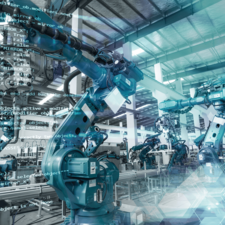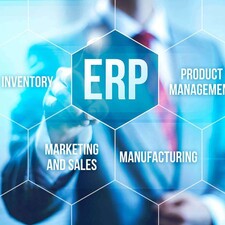Blog
How IIoT (Industrial Internet of Things) Drives Agility

Summary
The IIoT Data-Enabled Future of Manufacturing
The Industrial Internet of Things, or IIoT, will be at the foundation of smart manufacturing in the coming years. We already know what the production and distribution centers of the future will look like. Automated and highly connected by data, with human workers and AI/robots working together in blended ways, with technology doing what it does best – routine, repeatable tasks and continuous data collection – and people doing what they do best – developing business strategies, planning, coming up with new ideas, coordinating the ecosystem, and making decisions informed by data.
agility is enabled by technology, data and people working together in real time
Industrial equipment and robots will have sensors that not only offer safety in environments where humans operate such as warehouses and production plants, but that will also constantly transmit relevant performance data that allows human decision makers to monitor key performance indicators (KPIs) and make course corrections/changes in real time. The word for all this is agility, and it’s enabled by technology, data and people working together in real time, creating an industrial ecosystem that drives efficiency at every moment. The IIoT can be viewed as a living, adaptable organism that sees and responds, that can thrive no matter how the market environment may change.
abas ERP can help you move confidently into the future. Learn more in the abas 2018 ERP overview:

3 Massive Benefits of the IIoT Eco-System
1. Real-time visibility into relevant data drives process improvement.
intelligence is driven by performance data collected and transmitted by sensors, then shared with decision makers to act upon
Multiple sensors on equipment and robots can share performance data in real time, meaning that decision makers, whether they’re part of the leadership team or on the factory floor, can monitor and tweak operations as they’re happening, driving ongoing process improvement. For example, if a production line is producing an unacceptably-high number of defective products, decision makers can quickly identify that problem, perform diagnostics/analytics to find exactly where the problem is coming from, and then remedy the problem in order to put production back on track in terms of quality. As the system learns about and remedies problems, it can then integrate lessons learned and adapt its processes in real time to drive continuous improvement. All of this intelligence gets driven by performance data collected and transmitted by sensors, then shared with decision makers to act upon.
Instead of needing to wait until the end of the day or the week or the month to view the relevant reports on production or warehouse performance, and then start analyzing where the problems arose and how to remedy them, an IIoT ecosystem gives decision makers the key data in real time, allowing them to fix emerging problems on the fly and integrate lessons learned into new, dynamic, and adaptable operational processes. That’s process improvement and agility at scale, in real time, and it’s the promise of IIoT.

2. Offering Analytics for decision making at all levels.
All data isn’t created equal, and each industry and manufacturing company will have different KPIs in different areas of their operations. The IIoT is customizable in terms of how it transmits and reports data to decision makers. So if your company makes equipment for other manufacturers, you’re supremely aware of how a failed or failing piece of equipment might disrupt a customer’s manufacturing operation, and that customer may even charge or penalize you for the disruption. So both the maker of this manufacturing equipment and the customer/user would be extremely sensitive to data about the maintenance and upkeep of that equipment.
Think about an airplane engine or a locomotive/train engine, for example. The ability to customize KPIs and monitor analytics allows anyone to monitor maintenance data and keep this critical equipment up and running. The ability to customize KPIs and data transmission to meet the particular needs of your industry and company, to track the data most relevant for you, is a game changer.
3. Predictive Analytics to support agility.
With the advent of machine learning and AI, the IIoT reaches another level. Data scientists can write algorithms that identify historical patterns, and, based on those historical data patterns, make predictions about the future. AI technology can, for example, find market opportunities in the data and retool the entire IIoT system to take advantage of them. If manufacturer X sells 25% more of its products in the northwest region in November and December, predictive analytics can identify that trend and bring the entire production and distribution system along with it to meet that increased seasonal and regional demand as it’s happening. The system, fully integrated and coordinated with data collected from multiple points, becomes “smart."
Your system is fully integrated and coordinated with data collected from multiple points
Products get made, parts and materials get ordered from suppliers to make those products, the warehouse is readied and might increase its shipping/handling capacity, etc., and all of this happens automatically, seamlessly.
What is at the Foundation of IIoT?
To take full advantage of the amazing benefits of the Industrial Internet of Things, you need to begin by integrating your systems and your data. Again, the IIoT is a data-driven eco-system that sits atop a foundation of shared data. If you have silos with your systems and your data, if the right hand doesn’t know what the left hand is doing (i.e., the warehouse and the production facility have no visibility into each other’s operations/performance, creating constant bottlenecks that make customers angry), then you simply cannot “do” IIoT until you integrate your systems and get data enabled as a business.
So you might start by integrating systems and giving everyone visibility into all relevant data. An ERP system is a great way of starting your journey towards IIoT. Of course you’ll need to add sensors to your equipment and customize dashboards so workers on the production floor can gain visibility into the KPIs/performance of your equipment. An ERP system supports digital enablement and, ultimately, the sort of operational agility that IIoT promises.
In the end, it’s all about connecting. You can get there from where you are today, but you’ll need to enable your people and systems to access and leverage data, to drive continuous process improvement based on collected data, to apply predictive analytics to adapt to demands even before they emerge. But the first step is getting your data house in order. ERP helps you do just that, providing a foundation for agility far into the future, no matter what that future might look like. More likely than not, the future of manufacturing will be driven by data and technology and the ability of organizations to change quickly. ERP is a foundation for all that, and more.

Learn more about the future of manufacturing - Download: ERP and the Digitization of Industrial Machinery Manufacturing


